Welcome to Card Game DB
Register now to gain access to all of our features. Once registered and logged in, you will be able to create topics, post replies to existing threads, give reputation to your fellow members, get your own private messenger, post status updates, manage your profile and so much more. If you already have an account, login here - otherwise create an account for free today!
Register now to gain access to all of our features. Once registered and logged in, you will be able to create topics, post replies to existing threads, give reputation to your fellow members, get your own private messenger, post status updates, manage your profile and so much more. If you already have an account, login here - otherwise create an account for free today!
Rise of the Kraken - Greyjoy Maesters Part 3
Jan 18 2013 06:15 AM |
JCWamma
in Game of Thrones
Small Council Rise of the Kraken JCWamma Greyjoy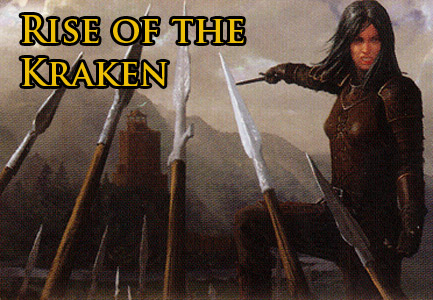 Hello, and welcome back to Rise of the Kraken, and having missed last fortnight we now look at the Maesters once more in a two-part spectacular! In parts 1 and 2 we looked at why Maesters are awesome and how to utilise them. This time round we look at their weaknesses, as well as a special interview with a Champion player...
Hello, and welcome back to Rise of the Kraken, and having missed last fortnight we now look at the Maesters once more in a two-part spectacular! In parts 1 and 2 we looked at why Maesters are awesome and how to utilise them. This time round we look at their weaknesses, as well as a special interview with a Champion player...The last two times I've looked at how the squids can utilise their Maesters, I've been overwhelmingly positive about their abilities, if for no other reason than because it genuinely baffles me how often they're overlooked. However, it'd be fair to accuse me of tunnel-vision if I didn't admit that this deck doesn't win literally every single contest it takes part in. Therefore, in the first half of this article we'll look at the biggest threats this deck can meet, how we'll try to deal with them, and how big a threat they actually are.
The second half of this article is an interview with the reigning European Champion of the game, Stefano Montanari. He offers his own perspective on the deck, gives his opinion on what is important in the game competitively, and explains exactly what you need to do to win - in other words, I categorically guarantee* that reading the interview will be enough to make you the European Champion for 2013!
*This guarantee is 100% genuine**.
**No it isn't.
PART ONE: PROBLEM CARDS/DECKTYPES FOR GREYJOY MAESTERS
First up is Targaryen burn. The problem here is obvious - one of the key components of a Maester deck is keeping Maesters on the table. One of the key ways in which Greyjoy complements that plan is with its multitude of saves. The only method of execution the saves don't work against are Terminal Burn effects - that is, reducing a character's strength to zero and inflicting them with a passive effect "killed if strength is zero". This is because even if you save them, their strength is still zero and the passive effect still applies, so the character dies anyway. Other houses can get a terminal burn effect (the easiest way being using Threat from the North (PotS) and Lead Link (CbtC)), but Targaryen is spoiled for choice in the matter - their options include but are not limited to Flame-Kissed (Core), Dragon Skull (CoS), Incinerate (VM) and the aforementioned Threat from the North, with the likes of The Hatchlings' Feast (ASitD) there to help your cards reach 0 Strength that much quicker.
There are two points at which this strategy can be combatted. The first is by ensuring your characters' strength never reaches 0. For your Maesters, the simplest way to accomplish this is with Apprentice Collar (GotC). That said, it's dangerous to rely on just the Collar. Targaryen also has nasty cards to discard attachments such as Meereenese Brothel (BtW) and Dragon Thief (AE). The more likely way to stave off the terminal effect is through a combination of cancel and stopping the selection of valid targets. Scout ahead and figure out which burn cards need which circumstances, and make sure they don't occur. Protect your key characters with attachments so that Flame-Kissed, The Hatchlings' Feast, and other cards such as King's Landing Assassin cannot target them. The Hatchlings' Feast, in particular, needs 3 characters without attachments in play to work - limit the number of characters without attachments in play to 2 or less and at worst they'll have to lower the strength of their own characters to get the job done. Others require you to simply cancel - Dragon Skull is a particularly great card to cancel, since the opponent may well overlook that the only reason it can attach to your character at all is that Response. Cancel the response and that card they paid a total 3 gold to bring into play is then immediately discarded, never even attaching. Also be prepared to cancel the events. Incinerate is a nasty one since it doesn't have any limit on target and requires influence so cannot be cancelled with Paper Shield (QoD). Finally, be prepared to use Newly Made Lord (TftH) to remove the aforementioned Brothel or Lady Daenerys's Chambers (Core) to stop the opponent from removing your protection or recurring their nasties.
The other point at which it can be combatted is once the terminal effect has happened. Greyjoy is almost unique in its ability to save from burn, due to its possession of cards that not only save but raise your strength, in the form of Risen from the Sea (KotS) and Moqorro (VD). There is also Rhymes with Meek (ARotD), but this suffers from being restrictive, needing influence and only targetting uniques. Of the other two cards, Moqorro isn't actually as important as you might think - he's great, but the opponent can plan around him because you can't catch anyone off guard with the ability since he's in play. He just means that the opponent needs to be able to burn away 2 more strength to get the kill. Risen From The Sea, on the other hand, is the perfect spanner in the works of burn because they don't know you have it until you've played it. The main issue burn decks face is they often have to use multiple cards to deal with your one, and as a result they generally can't afford to burn away any more strength than is needed, so that +1 Strength makes all the difference. At worst, they have to commit an extra card to get their kill; in an ideal scenario they've just spent a card, maybe even two or three, for nothing. Risen also has the extra boost of becoming an attachment, deactivating Flame-Kissed, and, with some "return to hand/top of deck" shenanigans that some cards offer, can actually be repeatable save.
The other trick Targaryen Burn has up its sleeve is the usual Targ recursion. This comes in the form of cancellable events and an Ally who can be discarded or blanked easily and cannot survive the Targ player's own Threat from the North. These cards can be problematic, but not worth losing sleep over for us.
Overall, a tough challenge, but if you can get a foothold of control in the game your deck should win out.
Next, the issue of blanking your cards. This is another way of removing your Maesters from play, by getting rid of their trait. The most common is the oh-so-nasty Meera Reed (TftH), but don't be remiss in the possibility of the opponent running Nightmares (LoW). There's even Margaery Tyrell (TftRK), and although she doesn't see much play, the potential for a nasty combo with Meera will scare you even though you'll likely never see it played against you. The most simple way of getting around this is by giving your chosen chain-dump the Apprentice Collar, meaning they retain the Maester trait. This works fine unless it's Winter, in which case prepare to see both your Maester and Collar blanked by Meera at once and all your chains fall off.
There is very little you can do to prevent this, in truth, and that's not a great feeling for a control player - that said, it's not as nasty as it appears at first sight. You just have to take precautions if you play Stark. Assume every card in the shadows is Meera unless you know for an absolute fact it isn't. Do not put chains on Wendamyr if you can help it, as that way your opponent is torn between discarding your chains and blanking your saves. Don't let your opponent return Meera to the shadows if at all possible - don't make military challenges if the opponent has a character they don't mind losing, don't use Dissension on a refugee in the Marshalling phase, and if they have a refugee out try to let them win dominance so they can't discard it to get Meera out of reach. With Meera out you can Valar to get rid of her, or use trait manipulation and Dissension. For Nightmares, the game is ov- oh wait, cancel it like you cancel everything. You do cancel everything, right?
These cards are annoyances, but there are nastier tricks out there. They slow your momentum, but in the long run they need other cards working with them to truly mess up your day.
The third way you'll likely see your Maesters removed is through you losing control of them. By far the biggest danger in this regard is Enslaved (THoBaW), although there's also the likes of Reek (MotM) and even Fury of the Stag (AE) to worry about. For the latter two, just don't lose the challenges, whatever you do. They necessarily telegraph themselves so you can play around them. For Enslaved, the solution is simple, and it is called Tin Link (CbtC). If you are playing Lannister, leave the link until last (or bring it off early to get rid of Enslaved cards), maybe even leave it until the challenge you win the game with so it's always a threat. If the opponent plays a second Enslaved, try to force them to kneel the character (so you can activate the link's response and discard Enslaved), or else just kill them off.
The timing of this is crucial. The worst thing that can happen is for you to not have great board position but manage to rush off all your chains, only for Enslaved to deny you your best character. However, if your opponent is forced to use it early, or alternatively when you already have them well on the ropes, you should be able to cope. Just be careful.
One of the hardest problems for Maesters to deal with is plot effects. The most-commonly played plot card that hurts our deck is The First Snow of Winter (ODG), but it's not the only plot that can cause difficulty - the when revealed effect of City of Sin (AToT) cannot be cancelled except through Outwit (TIoR) and can be repeated with City of Spiders (TftRK). Meanwhile Marched to the Wall (LoW) and Wildfire Assault (Core) get past your saves. With the addition of Maester Kerwin, Outwit is thankfully now a viable card to use, and in the case of City of Sin/Spiders the opponent needs to have played a few City plots already to get a serious effect with them, but they're still well worth looking out for. Meanwhile, nasty passive effects like Threat from the North (PotS) and the aforementioned First Snow can be dealt with either through Forgotten Plans (KotStorm) or Citadel Law (MotA). That said, if you don't have Citadel Law in hand then timing Forgotten Plans can be quite tough at times, so watch out.
The final threat I'm going to talk about is Rush. This is going to be a fairly simple discussion point, as you should already know what a rush deck is (and if you don't, try to guess based off the name - and if you read this in the future and still can't figure it out, I believe the First Tilt articles are planning at looking at what different deck archetypes mean at some point, so maybe they've done that by now and you can check there). Maesters decks start with a great card advantage, as I outlined extensively in part one of this series. However, if a Rush deck can overwhelm you early on, it can be difficult to stop. Valar is no guarantee of slowing the opponent down thanks to The Power of Blood (Core).
My suggestions here are simple, and it basically boils down to "build a good deck that can start quickly". Other than blanking text boxes or removing characters (the only targetted removal you're likely to have being Dissension) there's not much of a way out other than to either out-rush, or survive said rush. Murenmure can help slow it down by cancelling reducers, the fact that these decks generally rely on a lack of shadows means your Boatswains will probably be at full power, and if the opponent plays Fear of Winter on the first turn, At the Gates probably means it will play into your hands. Good luck!
These are not the only cards and decktypes that can cause trouble for Greyjoy Maesters, and I'm certainly not suggesting you should relax when playing other decks - however, I do feel they are the main threats in the current meta. If you can construct the deck in a way where you feel confident in taking on these different decks, you should find yourself in good stead.
PART TWO: STEFANO MONTANARI INTERVIEW
In November of this year, Stefano (Steph80) guided a Greyjoy Maester deck (decklist available here) to victory in the European Championships of Stahleck. Stefano's not only a superb player but an awesome person, and thus he graciously let me ask him a few questions about his tremendous victory, which include great thoughts on the decktype and advice for all players, both those of us who play Greyjoy Maesters and anyone else beyond.
Q: You address this to an extent in your tournament report for the Stahleck website, but what made you choose Greyjoy Maesters over any other deck?
Stefano: When I build a deck the key concept I focus on is Card Advantage. In AGOT, you have to think about Card Advantage as the ability to increase your resources or disrupt those of your opponent. For many players, the term Card Advantage can be summed up simply in the number of cards you can draw or reveal to add them to your hand from your deck. In fact, the concept is much broader - the true card advantage is the number of permanent cards in play controlled by a player plus the number of cards in his or her hand.
The Maester’s Path Greyjoy deck is absolutely outstanding mechanically in the current metagame to ensure you have the card advantage.
Let's briefly examine the characteristics:
- TMP AGENDA: Let's you immediately search for (and gain easy access to) a variety of cards to attach to Maesters. Theoretically in AGOT we have up to 6 challenges per round (3 on offense and 3 on defense) - this means that you can potentially add up to 6 permanents in a single round, which is possibly the most monstrous card advantage mechanic currently in the game. I have to agree with the criticism this agenda receives, although I think the solution lies in balancing the game with other strategies as valid as Maester ones rather than limit the existing ones.
- VALYRIAN STEEL LINK and LONGSHIP IRON VICTORY: Card Advantage simply by drawing more than your opponent. Obviously very strong, especially the former as it sits on your agenda and can be in play from turn one.
- RISEN FROM THE SEA
– THE IRON MINES
– IRON CLIFFS: This card advantage is almost unique to the Greyjoy House, saving permanents from being killed. It can quickly overwhelm the opponent. Risen becoming an attachment to boost strength and the Iron Cliffs allowing two saves for one card mean they're also efficient.
- NEWLY MADE LORD: This is a perfect card advantage card with a passive effect that opponents cannot easily prevent; moreover you get a good permanent in the form of a 3 strength character for power challenges (and maybe some more with the help of your tricky chains).
After those cards I want to talk about my favourite type of cards. These cards provide a huge Card Advantage because not only do they incorporate the tremendous effects that normally require an event, but they are repeatable effects rather than "one-shot resources". These cards are absolutely the main reason behind my preference for the Greyjoy house right now.
- MOQORRO and MAESTER WENDAMYR: More save, but repeatable since you only need to kneel them and this time you get an even better deal - With MOQORRO you get a useful keyword and more strength, while with Wendamyr you can stand him to use him again in combination with a learned character. Amazing.
- MAESTER MURENMURE and ALANNYS GREYJOY: These are my favourite cards, they have so many uses. In Marshalling you can stop events like Dissension, locations like all the Seas or Responses like the ones of Flea Bottom Scavenger. If Alannys Greyjoy is on the table and active then you can almost feel safe from all the nasty tricks your opponent can do.
- BAELOR BLACKTYDE: An overlooked type of card advantage is virtual card advantage - when your opponent has cards, but they cannot play them for some reason. In AGOT the common situation is the when a player has a copy of a unique character in his or her deadpile and another in his or her hand. Baelor does the same to events and if you think that normally each player will build his deck with multiple copies of events, it is easy to understand the power of this card, able to prevent many threats.
Finally, she isn't Card Advantage but I’d like to include Asha Greyjoy. She is a must!
Q: How much do you think the victory was down to choices you made at the deckbuilding stage, and how much do you think it was down to the decisions you made match-to-match? In other words, how much was Driver and how much was Car?
S: I often hear that AGOT is a game where the most important aspect is the player, being able to win based on the cards he or she draws. Actually in AGOT, you can control your luck a lot, both at the deckbuilding stage but also when selecting plots. At the plot-selection stage we highlight the most important skills of the players who can think on multiple levels - so a novice player will think to choose the Plot that best suits considering the cards at his or her disposal, while more experienced players choose their plot in relation to the choice that they think their opponents will make. Finally, the players who have mastered the game will be able to assess what their opponent might think about them and be able to bluff, surprise them and lead them into making an error. The easiest example of this is Valar Morghulis - a very strong plot, but often strongest when it's unexpected. So there is certainly a lot of player skill there.
That said, in my experience, especially in this game, the choice of the right deck has a huge part in the result that a player can get in a tournament. This conviction I want to explain in the best way possible because I do not want to be misunderstood.
In other card games, decklists that win major tournaments are often published and copied by all the players who are part of that circuit without distinction of their level or ability. The differences will then emerge during tournaments, because despite having begun as the same deck or decktype you will find that the best players have made ​​choices that are more refined, perhaps because they've thought about the mirror match or perhaps because they are focused on the most advanced stages of the tournament, evolving the deck and making it more solid.
I lost tournaments simply because my deck lacked one or two cards that would have made ​​the difference and unfortunately I found out after the fact, and I constantly improved my deck. That said, at the same time I see many players who are more focused on creating a deck than winning a tournament, because they're determined to get their deck to work. So often you play tournaments that are unbalanced because you have strong players driving leading Tier 1 decks that are very solid and are tested properly, and they're against players who have no hope because their decks are harder to drive. After a few tournaments those players are demoralized and maybe shelve the game because it seems too difficult - in fact they couldn't win in the first place because they decided to take part in a Formula One race in a Fiat 500.
To those players I would say to feel free to play experimental decks during playtesting, but in a tournament try to play competitive decks and do not care about those who built the deck. Don’t worry about people that say that copying is bad, because creating a deck is nice but will not let you win the tournament alone. People will remember you because you are a good player not because you are a good inventor of decks.
Q: Do you believe the deck was lucky to win the competition, or do you believe that Greyjoy Maester was the best deck in the meta at the time of the competition?
S: No I think this is a great deck with the best Agenda and many fabulous cards as said before. However, I also believe that there are other decks that can perform as well as the Greyjoy. AGOT is a great game and very dynamic, always moving quite fast! No matter if you are planning to play in a tournament of 14 people or 140 people, the new Chapters bring strategies and action to the game and therefore the metagame. In a small tournament you probably know all the decks and choices before it starts, so you can build your strategy a few days in advance. This means that you can also go with a deck specifically design to defeat your metagame. In a larger tournament you simply have to bring the deck that you think is the best, and that proves to have good match-ups against a wide range of decks so you're prepared for anything.
Q: Were there any cards you weren’t sure whether to include in your deck, but are glad you did? Conversely, were there any cards you are glad you didn’t include?
S: The Bronze Link. I think it could be necessary but it wasn’t. Conversely I’m happy I didn’t include any non-chain attachment because in the current meta I think that normally is a dead card.
Q: What cards or builds that opponents might use did you fear the most? Was it the usual suspects like Meera Reed, or were there any more unusual cards you were worried about? If there were any specific cards or builds you worried about, did you alter your deck to deal with them, or did you just hope for the best?
S: The Greyjoy is a control-tempo deck, so the huge problem comes from Rush decks. I fear Baratheon because in some case it could create hopless situations for this deck. Also, in the final I faced a clever and atypical deck driven by a great player in Humber. That was a Stark Siege with epic phases, and the problem wasn’t the kill effects but the speed at which he could grab power. Meera Reed is a problem, but not impossible to manage for this deck.
Q: If you had to play the tournament again with the same deck, are there any changes you would make to it?
S: I like Wintertime Marauders + winter and knowing the field of Stahleck is always full of Stark players I think that Theon Greyjoy is an auto-include.
Q: What advice would you offer to any budding Greyjoy Maester player (or indeed, any player) who is perhaps lacking confidence or is intimidated by the thought of a big tournament atmosphere?
S: I suggest forming a team with your friend(s). Share ideas and thoughts with them. Plan to come to any big tournament with them. And do not forget that any new opponent could be your next new friend.
Q: Finally, as the winner of Stahleck 2012 you won the right to design a card of your own. Obviously you can’t tell us the champion card you want to make, but do you have any hints to tantalise us with?
S: I’d like to make a card that recalls the evocative atmosphere of the books of George R.R. Martin. Therefore, I certainly want it to be strong in the point of view of the players, but also consistent with the story from the point of view of the fans. Unfortunately at the moment I cannot say more.
Congratulations to Stefano - in the Game of Thrones, he won and the rest of us died. Stefano is part of the Milan meta. They're hosting a 'Road to Stahleck' tournament on the 25th-26th May with 1st prize being free entry and travel costs for this year's Stahleck tournament in November. Read all about the details HERE!
That's all for this edition of Rise of the Kraken - check back in one fortnight for the next edition, in which Gangle will have a look at the always-fun issue of milling. Have any questions, or anything to add, or questions I should've asked Stefano? Feel free to post them in the comments!
- WWDrakey, Amuk, Archrono and 4 others like this



 Sign In
Sign In Create Account
Create Account
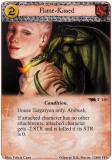
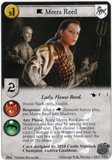
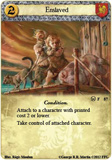
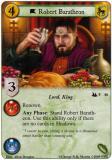











13 Comments
(e): Also the Stahleck tournament sounds amazing.
That's actually a common misconception that probably partly arises from both of the first blanking cards in the Core Set happening to not blank traits (Milk and Renly's Courtier (Core)), so people tend to form a mental shortcut to it.
Cheers!
If you look at the text on The Power of Blood (Core), it directly states that "You may have up to 2 copies of The Power of Blood in your plot deck.", thus directly contradicting the rule of only having a single copy of a Plot in your plot deck, and allowing you to actually wield 2.
@C7Payne: As Drakey says, these cards you can have multiples of because the card says you can. When the card text and rules disagree, then unless the card has been errata'd you go by what the card says - the Golden Rule, as Drakey said!